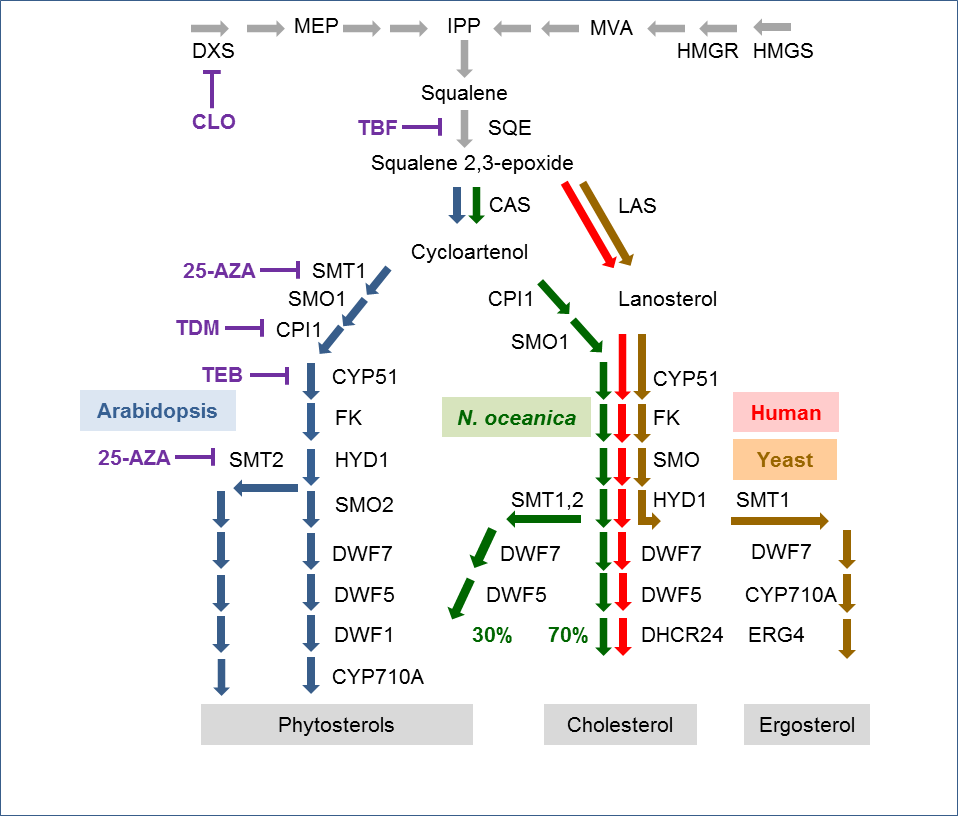
QIBEBT Reveals Biosynthetic and Regulatory Mechanisms of Steroids in Microalgae
Jun 04, 2014 Email"> PrintText Size

Sterols are vital components of all eukaryotic cells. However, little is known about the roles, biosynthesis, and regulation of sterols in microalgae. A joint research team led by Qingdao Institute of Bioenergy and Bioprocess Technology, Chinese Academy of Sciences (QIBEBT) and Centre of Excellence in Plant Energy Biology, University of Western Australia (UWA) has now reported the unique sterol biosynthetic pathway and revealed co-regulation of sterol production and fatty acid (FA) synthesis in an oleaginous microalga. This work appeared in Biotechnology for Biofuels (Lu, et al, Biotech Biofuels, 2014).
Nannochloropsis spp. are a group of wild oleaginous microalgae that are widely distributed in the oceans and are cultivated world-wide. Dr. LU Yandu from Single-Cell Center, QIBEBT, Dr. ZHOU Wenxu from UWA and their colleagues found that N. oceanica exhibits features of both higher plants and mammals (Figure 1). Temporal tracking of sterol profiles and sterol-biosynthetic transcripts in response to changes in light intensity and nitrogen supply reveal that sterols play roles in cell proliferation, chloroplast differentiation and photosynthesis.
Furthermore, the dynamics of FA and FA-biosynthetic transcripts upon chemical inhibitor-induced sterol depletion reveal possible co-regulation of sterol production and FA synthesis. A feedback regulation of sterol and FA homeostasis is proposed, with the 1-deoxy-D-xylulose 5-phosphate synthase (DXS, the committed enzyme in isoprenoid and sterol biosynthesis) gene potentially subject to feedback regulation by sterols. Together with molecular model of oil synthesis in N. oceanica proposed by this research team (Li, et al, Plant Cell, 2014), the sterol-dependent fatty acid regulatory mechanism discovered here suggests new genetic engineering or chemical biology approaches for enhanced oil production in microalgae.
This research was supported by the National Basic Research Program, and the International Innovation Partnership Program from the Chinese Academy of Sciences. Prof. XU Jian from Single Cell Center, QIBEBT and Steven M Smith from Centre of Excellence in Plant Energy Biology, UWA led the study.

Figure 1. Features of biosynthetic pathway of steroids in the oleaginous alga Nannochloropsis oceanica
(Image by Single Cell Center, QIBEBT)
Contact:
Prof. XU Jian
Single-Cell Center, Qingdao Institute of Bioenergy and Bioprocess Technology, Chinese Academy of Sciences
E-mail: xujian (AT) qibebt.ac.cn
Web: http://english.qibebt.cas.cn
Sterols are vital components of all eukaryotic cells. However, little is known about the roles, biosynthesis, and regulation of sterols in microalgae. A joint research team led by Qingdao Institute of Bioenergy and Bioprocess Technology, Chinese Academy of Sciences (QIBEBT) and Centre of Excellence in Plant Energy Biology, University of Western Australia (UWA) has now reported the unique sterol biosynthetic pathway and revealed co-regulation of sterol production and fatty acid (FA) synthesis in an oleaginous microalga. This work appeared in Biotechnology for Biofuels (Lu, et al, Biotech Biofuels, 2014).
Nannochloropsis spp. are a group of wild oleaginous microalgae that are widely distributed in the oceans and are cultivated world-wide. Dr. LU Yandu from Single-Cell Center, QIBEBT, Dr. ZHOU Wenxu from UWA and their colleagues found that N. oceanica exhibits features of both higher plants and mammals (Figure 1). Temporal tracking of sterol profiles and sterol-biosynthetic transcripts in response to changes in light intensity and nitrogen supply reveal that sterols play roles in cell proliferation, chloroplast differentiation and photosynthesis.
Furthermore, the dynamics of FA and FA-biosynthetic transcripts upon chemical inhibitor-induced sterol depletion reveal possible co-regulation of sterol production and FA synthesis. A feedback regulation of sterol and FA homeostasis is proposed, with the 1-deoxy-D-xylulose 5-phosphate synthase (DXS, the committed enzyme in isoprenoid and sterol biosynthesis) gene potentially subject to feedback regulation by sterols. Together with molecular model of oil synthesis in N. oceanica proposed by this research team (Li, et al, Plant Cell, 2014), the sterol-dependent fatty acid regulatory mechanism discovered here suggests new genetic engineering or chemical biology approaches for enhanced oil production in microalgae.
This research was supported by the National Basic Research Program, and the International Innovation Partnership Program from the Chinese Academy of Sciences. Prof. XU Jian from Single Cell Center, QIBEBT and Steven M Smith from Centre of Excellence in Plant Energy Biology, UWA led the study.
Figure 1. Features of biosynthetic pathway of steroids in the oleaginous alga Nannochloropsis oceanica

(Image by Single Cell Center, QIBEBT)
Contact:
Prof. XU Jian
Single-Cell Center, Qingdao Institute of Bioenergy and Bioprocess Technology, Chinese Academy of Sciences
E-mail: xujian (AT) qibebt.ac.cn
Web: http://english.qibebt.cas.cn
CAS Institutes
There are 124 Institutions directly under the CAS by the end of 2012, with 104 research institutes, five universities & supporting organizations, 12 management organizations that consist of the headquarters and branches, and three other units. Moreover, there are 25 legal entities affiliated and 22 CAS invested holding enterprisesThere are 124 I...>> more
Contact Us

Chinese Academy of Sciences
Add: 52 Sanlihe Rd., Xicheng District, Beijing, China
Postcode: 100864
Tel: 86-10-68597592 (day) 86-10-68597289 (night)
Fax: 86-10-68511095 (day) 86-10-68512458 (night)
E-mail: cas_en@cas.cn

